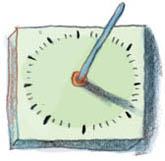


Long ago, people told time by the sun, moon, and stars. Telling time by where the sun was in the sky, called solar time, was most common. Eventually people developed sun clocks, or shadow clocks, to help them keep time by the sun. Ancient Egyptians erected obelisks, tall monuments to the sun god, Ra, that cast long shadows by which they could tell time. Sundials, another timekeeping invention, were often portable and even more accurate. However, solar-based methods of telling time were limited by the weather and the time of day—if it was dark or cloudy, there would be no shadow!
For this reason people developed other tools for telling time. They developed water clocks, which poured water at a certain rate, or used the length of time it took a candle or oil lamp to burn to track how much time had passed. The pendulum clock was invented in the 17th century, and soon other mechanical clocks were developed as well.

Because the sun rises and sets at different times in different places due to the rotation of the Earth, clocks set by the sun aren’t accurate between regions. For example, when using solar time, the time in New York and Boston differs by about eight minutes. But imagine if you were traveling farther! The differences would be greater, making solar time even more inaccurate. Once communication by telegraph and travel by train became more common, the small differences in solar time between regions became problematic. Can you imagine not knowing when a train would arrive or depart?
Several different people came up with the idea of establishing time zones, but Sir Sandford Fleming is generally credited with the invention. He proposed a worldwide system of time zones based around a 24-hour clock using Greenwich, England, at 0 degrees longitude as the reference point. He presented his idea to the International Meridian Conference in 1884, at which time Greenwich was established as the prime meridian.
Each time zone is a vertical section of the globe from the North Pole to the South Pole. But the time zones aren’t always a straight line—this is to make sure one city isn’t separated in to two time zones! Most time zones are 15 degrees apart from one another (a sphere like the Earth has 360 degrees, which when divided by 24 time zones, equals 15 degrees per time zone!), but large countries like China and India, for example, choose to use one time zone for the whole country.
Each standard time zone is one hour apart from the next standard time zone. If you were heading east from the prime meridian, you would add an hour to whatever time it is in Greenwich, England, for each time zone you pass. If you were heading west from the prime meridian, you would subtract an hour from the time in Greenwich, England, for each time zone you pass. Some areas observe daylight saving time, which is when a time zone changes their clocks at certain times of the year to take advantage of the natural sunlight. When an area observes daylight saving time, the standard one-hour time difference between time zones can change.

We now use Coordinate Universal Time, or UTC, rather than Greenwich Mean Time, or GMT. UTC is measured by atomic clocks and uses leap seconds to account for gradual slowing in the Earth’s rotation, so it is more accurate than GMT but still uses the prime meridian as its reference point. There are now about 40 time zones in the world (some of these time zones are not a full hour apart from one another, but 15, 30, or 45 minutes from a neighboring time zone).
Today we have the ability to measure and synchronize time more accurately than ever before. For example, quartz watches and clocks are accurate to better than one second, and atomic clocks are accurate to one trillionth of a second, per day. This level of accuracy allows for technology like the Global Positioning System, or GPS—technology powered by a satellite that can tell where you are at any given moment in time—to function.